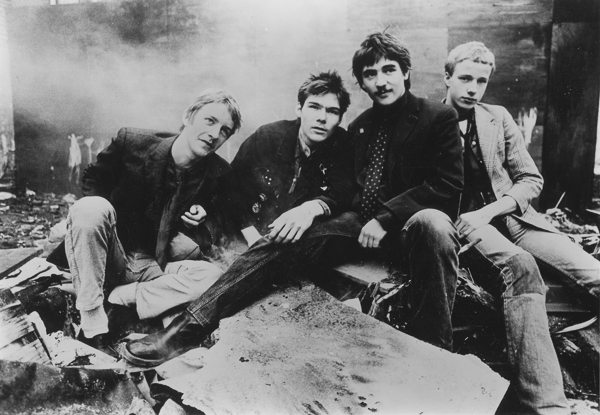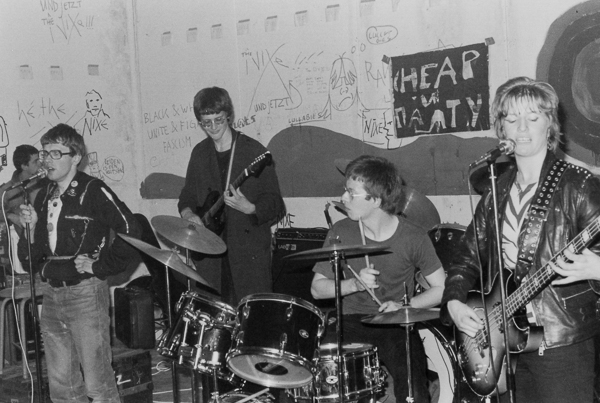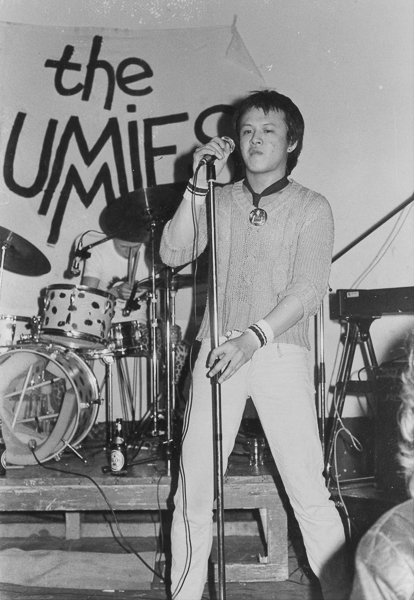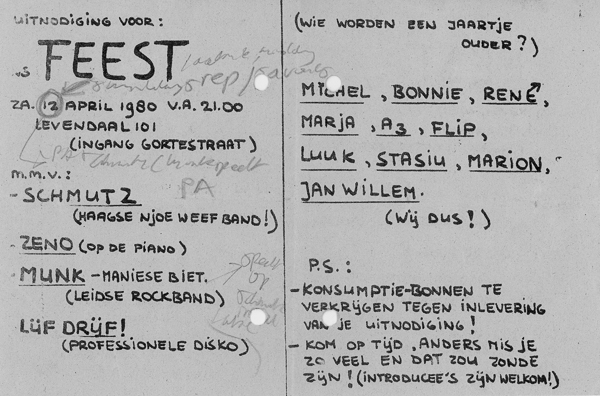PUNK IN THE LEIDEN REGION, 1975-1982
By Herman de Tollenaere
Leiden is a city of about 100,000 inhabitants. A lot smaller than Amsterdam and Rotterdam. Still, the greater Leiden region was important for the early years of punk in the Netherlands.
In Hazerswoude village in 1975, the Ivy Green teenagers started to develop their own brand of music without knowing about developments in New York City and London at that time. They became the most important Dutch first wave punk band. One of the very few Dutch punk bands who got a major label record deal to make an album.

Next, it turned out that Ivy Green faced at least four obstacles:
1. Their own record label bosses. In September 1978, I took their album to London. Small Wonder Records and Rough Trade wanted to import hundreds of Ivy Green albums. I left my LP in England, feeling sure that I would be able to buy another copy. Success in Britain might have caused success in the Netherlands. But multinational corporation Atlantic being a multinational corporation refused to export to Britain. And record shops in Leiden told me: not another Ivy Green album for you, it is sold out.
2. Record shops. Peter of the band Panic told me that he was at a record store when Ivy Green albums got delivered. ‘Can I buy one?’ The shopkeeper replied: ‘Yes, you can buy one, because you happened to see it being delivered. I always send stuff like that straight back immediately.’ A record store in the greater Leiden region had no such anti-punk prejudices. Yet it turned out that they had never heard about Ivy Green.
3. Dutch radio and TV. Where you could either have disco, or ‘Adult Oriented Rock’ big label music. ‘I have completely by-passed punk, as I thought it was bad music, which never meant anything to me and never will.’ Thus spoke Frits Spits, leading disc-jockey of the main music radio station in the Netherlands, Hilversum 3, during an interview with Martijn Stoffer, Oor, 1th of November 1978, page 17. And the rest of Dutch TV and radio followed Mr Spits´ lead. There was no John Peel in the Netherlands. Overwhelmingly Tony Blackburns.
4. Simon, bass player of Ivy Green’s mandatory military service meant they could not rehearse.
All that led to Atlantic refusing to release their second album, thus dropping the band. They kept on playing to enthousiastic audiences.
Meanwhile, Leiden born drummer Saskia aka Syama de Jong, in 1975-1976 living now in Paris, then in London, was the only Dutch person participating in the origins of punk around Vivienne Westwood’s and Malcolm McLaren’s shop and in the squats where bands like the Sex Pistols, the Damned, the Clash and the Slits were born.
In 1977 in Paris, Ms. de Jong started one of the earliest European continental punk bands, also the first ever all-women rock band in any genre in France: the Lou’s.
In spring 1978, Pin started in Warmond village north of Leiden, and Leiden. It was then the only non-Amsterdam fanzine. In late 1978-early 1979, when its Amsterdam colleagues Razorblade and Koekrand were pausing, it was the only punk fanzine in the Netherlands, the Koekrand wrote later. In January 1979 they published a joint issue with Razorblade to celebrate half a year of Pin, one year of Razorblade. The two fanzines opened a squat venue in the NRC building near the Dam square in Amsterdam. The first concert, celebrating the one year/half a year jubilee, was on 19 January, with Ivy Green, the Bugs, Infexion, Motorboat, VD Patients and Jezus and the Gospelfuckers playing. Eventually the name of the club became No Name.
Pin published the first ever Dutch fanzine interviews with bands like Ivy Green, Crass, Poison Girls and the Raincoats. It was first to mention the U.K. Subs. It was first in interviewing a band (Chelsea) in London. In its first issue, it advocated starting a Rock Against Racism movement like in Britain in the Netherlands. I participated for Pin in founding such an organisation months later, proposing that Ivy Green should play at the first RAR concert; thus happened.
Pin was the first publication, mainstream or underground, from anywhere to interview the new band of ex-Damned guitarist Brian James, the Brains, when it was founded in 1979.
Founding Pin proved to be easier for me than founding a band. I had bought a second hand electric guitar in early 1978. A girl in Oegstgeest village had a bass guitar. But neither of us had an amp or musical experience. So, we were not really a band yet.
In November 1979 I met bass player/vocalist Terry in Leiden. She lived in Delft then. Meeting again at a Ruts concert on the 7th of December 1979 in Paradiso, Amsterdam, we decided to start a band. Very soon, a drummer and a guitarist from Sassenheim, a village north of Leiden, joined. After considering Vermin as a band name first, we became Cheap ‘n’ Nasty.
We knew that British bands Crass and Poison Girls would be on tour in the Netherlands in March. An attempt to organise a concert by them in Leiden at the biggest local venue, the LVC, failed. Like it had failed in 1978, because of opposition to punk by the LVC management.

Next, an attempt to have Crass and Poison Girls play at the big hall in the local squat Levendaal 101, where Cheap ‘n’ Nasty rehearsed, failed. Pin had tried to start a club in that hall. Four Utrecht punk bands, the Lullabies, the Nixe, Rakketax and Noxious had played there. But resistance among some of the squat’s inhabitants had thwarted a plan to have the U.K. Subs, Infexion from Amsterdam and Ivy Green. Likewise, a Crass/Poison Girls concert proved to be impossible.
At the eleventh hour, the Lindehoeve venue in Voorschoten, south of Leiden, then agreed to have a punk and new wave festival, with Crass, Poison Girls, Cheap ‘n’ Nasty and three other young regional bands, from Leiden, Sassenheim and Voorschoten on the 25th of March 1980. Cheap ‘n’ Nasty drummer Maarten played drums both with Cheap ‘n’ Nasty ànd the Perfect Grandmothers. Sassenheim bands, like the Long Haired Kojaks, often sounded somewhat experimental rather than ‘mainstream punk’.
In 1978-1980, most of the punk scene in Leiden city were from blue collar families. The editorial board of Pin consisted of junior technical school pupils, of someone working for the minimum youth wage at Heineken brewery, of one on the dole. Their leftist parents were far more positive about their children becoming punks than, eg, evangelical Christian parents.
In January 1980, four Leiden 12-13-year-old girls founded Sub-trax, the youngest punk band in the world. They were also, after the Nixe from Utrecht, the second ever all-women punk band in the Netherlands. They were written about in fanzines in Leiden, Voorburg, Groningen and Rotterdam. National VPRO radio interviewed them.
Their aim was to play at the March Crass-Poison Girls-Cheap ‘n’ Nasty-other bands festival. Their bass player, daughter of an electricity plant worker/Communist Party member said half-jokingly, half seriously to the singer: ‘We are all working class. Except you. You are a capitalist kid. So, you are not a real punk’. As it happened the vocalist’s family was a bit more well-off than the others’, but not capitalist. The father of the Sub-trax Algerian Dutch drummer did not allow his daughter to play on stage. So, at the Crass-Poison Girls concert, the youngest punk musicians in the world became spectators rather than support band.
Two bands founded in 1979 were Average Power from Oegstgeest and the Dummies from Leiden. Average Power disbanded, as they were unable to get gigs. Their drummer joined the Dummies. He also started a fanzine Power Flower, in 1980. The Dummies’ singer was Oor music paper journalist Swie Tio. They did manage to get concerts. And even a record deal; which, however, went wrong. They disbanded in 1980. Their drummer joined another band, Rabies, which later changed their name to the Prime Ministers.
In July 1980, when Terry stayed in London at Burleigh House (demolished in December 1980), with the Poison Girls, Andy (N.A. Palmer (Crass) phoned her to ask permission for including the Cheap ‘n’ Nasty song Thalodomide on what later was to be the first Bullshit Detector compilation. At the nearby Crass residence Dial House, she met up with Herman and London band Zounds. They decided there would be a joint tour of Zounds and Cheap ‘n’ Nasty.

Once back in the Netherlands a tape of the song was sent to England as requested, but eventually Crass decided that they did not properly understand situations in other countries and therefore they would not include foreign bands.
Cheap ‘n’ Nasty asked Bureau Pinkpop in Limburg in September 1980 to open for the U.K. Subs concert in Venlo. Pinkpop did not want to pay for a support band. Then, Subs singer Charlie Harper intervened, paying the petrol for Terry’s car. After Cheap ‘n’ Nasty had played, the U.K. Subs said: ‘Come back to play with us any time!’ Like happened in 1981 in Eindhoven.
For three weeks in November 1980, Zounds stayed in Leiden from where they toured with Cheap ‘n’ Nasty in the Netherlands, Berlin and Belgium.
The tour included a concert by both bands in the Leiden LVC. Its management didn’t like punk, but were under the impression that Zounds were an English Mod band, so they could play. Local punks Cheap ‘n’ Nasty were not welcome. So, the support band for that gig were announced as the mysterious Photo Models, supposedly also from England. Most punks in Leiden knew that the Photo Models were really a pseudonym of Cheap ‘n’ Nasty (I’m a photo model is a Cheap ‘n’ Nasty song). The LVC management did not realize what they were in for until the ‘Photo Models’ started playing. They tried to stop the band, but gave up that attempt because of indignant reactions by the audience. The showgoers reacted enthusiastically to the concert.
It became clear to the LVC management they could not keep punk out forever. So, a punk café started on Saturday afternoons. In that café, however, Cheap ‘n’ Nasty was still not allowed to play.The Prime Ministers and World War Rockerz from Haarlem did play there. And when the British Mo-dettes played, the local Miami Beach Girls opened for them.
In spring 1981, Cheap ‘n’ Nasty recorded the four-song Covergirl EP on their own label. Dutch avantgardist music magazine Vinyl interviewed them. They wrote that the EP ‘made them feel like cheering’. British weekly Sounds wrote: ‘Original ideas and a unique slant, but not less punk’.
Meanwhile, drummer Saskia de Jong, formerly of the Lou’s, had returned to Leiden. She founded a new all-women band, the Miami Beach Girls. With as their singer Maria, Cheap ‘n’ Nasty drummer when Maarten could not play because of secondary school. She also played the drums on one of the four Covergirl EP songs. The Miami Beach Girls played their first gig on May 16, 1981, opening for Cheap ‘n’ Nasty celebrating the release of their EP. It was the first concert in a new Leiden venue, the Jam, as, ’of course’ the release of their record could not be celebrated at the LVC.
In early summer 1981, Raphaelle Devins, French co-founder of the Lou’s, now also in Leiden, joined Cheap ‘n’ Nasty as saxophone player. When the band went to England in August, Raphaelle could not join that tour as having four people plus instruments in Terry’s tiny car was already a challenge.
After playing Ipswich Cheap ‘n’ Nasty drove down to London for their Sounds interview, for replenishing Rough Trade’s stock of Covergirl EPs, and replenishing Terry’s stock of hair dye at the shop next to Rough Trade. In August, Cheap ‘n’ Nasty were headline band at the big hall of Paradiso, with the Miami Beach Girls opening. It was guitarist Kees’ last Cheap ‘n’ Nasty concert. He had trouble in combining with his job, his night school and his other band, the Brommers. Terry also left, as she wrote her songs on bass for Kees’ guitar.
With a new, younger, line-up, Cheap ‘n’ Nasty continued till the end of 1982. Playing in Leiden, elsewhere in the Netherlands and Belgium. The austerity policies of the Dutch government hit youth clubs, limiting opportunities for concerts. Venues asked bands to send audio cassettes. Subsequently, venues lost these cassettes. As it became impossible to get gigs, Cheap ‘n’ Nasty stopped. They did not disband. They just could not play any more.
VENUES
In a sense, the first punk venue in the Leiden region was het Keldertje in Hazerswoude in 1975. Not a venue in the way that bands played there. But young people could meet there, Ivy Green was born there. It soon closed down.
Later, it turned out that big venues in Leiden city were not very punky. The Stadsgehoorzaal, a hall mainly for classical music and for Pink Floyd, was offered a January 1978 Blondie gig. They refused, as they had heard that Blondie was ‘a dangerous punk band’. A Blondie concert, planned in July 1978 in the big Groenoordhallen venue, did not go ahead either.
In early 1978, there were sporadically punk bands in the LVC. The British-Amsterdam band the Softies played there once. A showcase gig included local Munk the Punk and his Flying Testicles amid the sounds of hippie bands usual for the joint.
At Leiden University student clubs, punk bands sometimes played. Munk the Punk played at SSR. So did the Flying Spiderz. The Softies played at Catena. In 1979, a Leiden Rock Against Racism night, including Ivy Green, was at Augustinus.
A complication was that these student clubs were basically for members. While most Leiden punk fans were not university students, but considerably younger teenagers.

In the same street as the LVC was Breehuys, at Breestraat 19. Smaller than the LVC, with less often concerts, they lacked the LVC management’s hostility against punk, though there were nights with disco music as well. Ivy Green played its second ever Leiden concert there on 28 December 1978. After that gig, a Breehuys cleaning woman told me: ‘After a disco night, we find money on the floor. After a punk night, we find safety pins’.
South of Leiden was the Lindehoeve in Voorschoten. In March 1980, the Crass/Poison Girls/Cheap ‘n’ Nasty/other bands concert there attracted an audience of hundreds. Quite a change for the Lindehoeve from nights with a folk singer playing acoustic guitar, when twenty people would show up. Cheap ‘n’ Nasty later returned twice to the Lindehoeve. The Miami Beach Girls played there as well, in 1982. In early 1982, both bands also played in Nieuw Nijevelt in Wassenaar.
